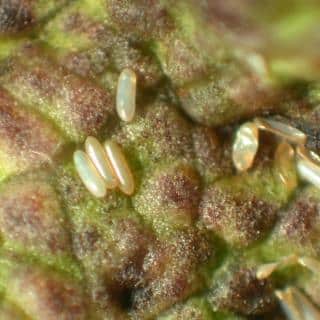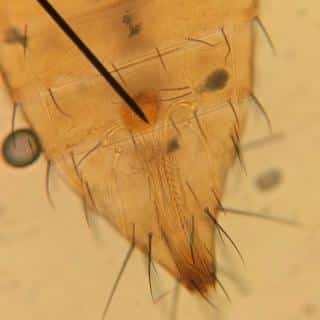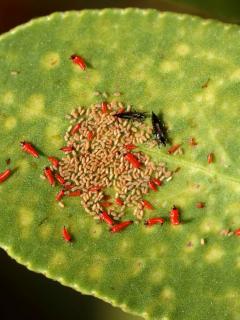

Thrips reproduce through egg-laying. Learn to recognize these tiny egg nests to prevent the pests from spreading across your plants!
Key thrips egg facts
Size – 1/64th inch (0.2 mm)
Per cluster – 2 to 200
Color – white or yellow
Location – inside leaves, stems, underside of leaves
Hatches in – 2-7 days
Thrips aren’t always dangerous, but knowing what you’re dealing with helps prepare for the worst. Locating thrips eggs is a first step.
Read also:
Thrips will lay their eggs either inside a plant, or attached to it.
Thrips eggs are lain in soft tissue. Most of the pest species actually lay their eggs inside the plant, in a small wound. These are typically thrips of the Terebrantia sub-order.
Sometimes this infection triggers galls on the host plant.

This special glue that is used is actually a combination of proteins and compounds the thrips produces. It’s very successful in preventing eggs from falling off due to wind and other disturbances!
For those that are inserted inside the plant, only one remedy: prune that part of the plant off!
For eggs attached to leaves or stems, simply rub them with your finger to remove them. You can also spray a mix of soap and water to suffocate the eggs.

The thrips then inserts a single egg in this wound.
The eggs are quite large compared to the adult. Each egg is often about one-fifth of the length of the adult thrips body.
Thrips of the Tubulifera order don’t have this ovipositor. Instead, they’ve developed powerful glues that seal their eggs in place.
Normally, for most insects, unfertilized eggs result in male hatchlings, whereas a fertilized egg produces a female specimen.
However, many thrips species are able to reproduce even when no males are present. This is called complete parthenogenesis. In this case, an unfertilized egg produces a female specimen. Usually this is the result of an infection by a particular bacteria that interferes with the reproductive system.

For thrips, the word “nymph” is more correct than the word “larva”.
As soon as they hatch, the thrips nymph is already equipped with mouthpieces to feed.
It even has a rather successful way of defending itself against predators! It curves its abdomen back upwards, and then releases the strain in a powerful flick! This helps it fight off many pest-eating insects like other beneficial thrips, ladybugs, and more!